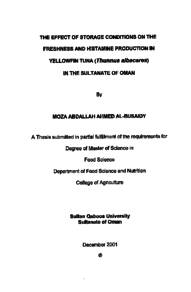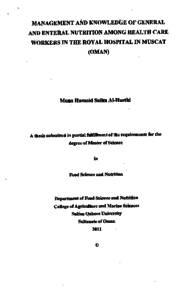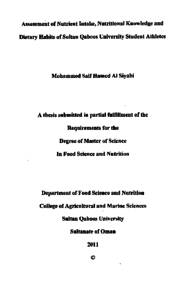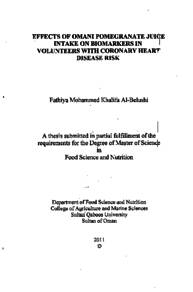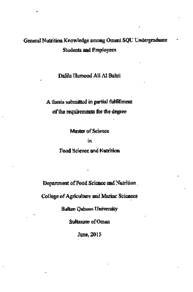Document
The effect of storage conditions on the freshness and his tamine production in yellowfin tuna (thunnus albacares) in the Sultanate of Oman.
Publisher
Sultan Qaboos University
Gregorian
2001
Language
English
Subject
English abstract
The present study was undertaken to assess the effects of storage conditions on the shelf life by comparing the sensory, microbiological and chemical quality attributes of yellowfin tuna (Thunnus albacares) caught in the Omani coastal waters. Using healthy muscle tissue, bacteriological changes, histamine formation and K values were determined for fish stored at temperatures of 0, 8, and 20°С. Sensory analysis was conducted on a whole yellowfin tuna (YFT) using a semi-trained panel that consisted of eight to ten assessors all of which had a food science background.
Results of the study showed that temperature is a critical variable for the quality and safety of fish. Storage at 0°C greatly extended the shelf-life of yellow fin tuna as compared to 8°C and 20°С. Freshness of YFT was assessed by K-value determination. Fish maintained its freshness up to 17 days, 6 days and 24 hours at 0°C, 8°C and 20°C, respectively.
Histamine levels declined during storage at 0°C with values within the acceptable levels specified by FDA (5 mg 100 g) and the European Union (10 mg 100 g:). This was in contrast to 8°C and 20°C where unacceptable levels were reached after 4 days and less than 24 hrs, respectively.
A rapid increase in the amount of histamine produced was observed when fish were stored at 8°C or 20°C. This correlated with an increase in the proportion of mesophilic bacteria when compared to 0°C.
Sensory evaluation was shown to be an effective method as bacteriological and chemical parameters were still within the acceptance limits when the fish became unacceptable in sensory terms.
Member of
Resource URL
Arabic abstract
لقد تم القيام بالدراسة الحالية التقييم أثر ظروف التخزين على الصلاحية بمقارنة الخصائص الحسية والمايكروبيولوجية والكيميائية الأسماك الجينر (Thummus albacares) التي يتم إصطيادها في المياه الساحلية العمانية. وقد تم استخدام أنسجة العضلات السليمة لتحديد التغيرات الميكروبية، وتكون الهستامين وقيم "كي" الخاصة بتحديد الحالة الطازجة للأسماك المحفوظة في درجات حرارة تبلغ صفر ، 8 و20 درجة مئوية. وقد قامت مجموعة شبه مدرية تتكون من 8-10 أفراد لكل منهم خلفية في علوم الأغنية بإجراء التحليل الحسي السمكة الجينر الكاملة.
أظهرت نتائج الدراسة أن درجة الحرارة تعتبر متغيرا حاسما لجودة وسلامة الأسماك. لقد زاد التخزين عند صفر °م فترة الصلاحية الأسماك الجينر مقارنة بدرجات الحرارة 8 و20م. تم تقييم الحالة الطازجة الأسماك الجينر بواسطة قيمة کی. حافظت الأسماك على حالتها الطازجة لفترة 17 يوم، ستة أيام ويوم عند درجات الحرارة صفر و8 و 20 °م على التوالي كانت قيم انخفاض مستويات الهستامين أثناء التخزين عند صفرهم ضمن المستويات المقبولة التي حلتها وكالة الغذاء والدواء الأمريكية (ملغ 100غم والاتحاد الأوروبي ( 10ملغ -100غ). هذا بخلاف درجات الحرارة 8 °م و20 م حيث وصلت إلى مستويات غير مقبولة بعد أربعة أيام وأقل من 24 ساعة على التوالي.
لوحظ حدوث ارتفاع سريع في كمية الهستامين المفرزة عند تخزين الأسماك في 8 °م و220م. هذا يتطابق مع زيادة في نسبة البكتريا المحبة للحرارة المعتدلة عند مقارنتها بدرجة الحرارة صفر م ا وقد أتضح أن التقييم الحسي طريقة فعالة حيث أن التحاليل المايكروبيولوجية والكيميائية كانت ما زالتا في نطاق الحدود المقبولة عندما أصبحت السمكة غير مقبولة من ناحية الحسية.
أظهرت نتائج الدراسة أن درجة الحرارة تعتبر متغيرا حاسما لجودة وسلامة الأسماك. لقد زاد التخزين عند صفر °م فترة الصلاحية الأسماك الجينر مقارنة بدرجات الحرارة 8 و20م. تم تقييم الحالة الطازجة الأسماك الجينر بواسطة قيمة کی. حافظت الأسماك على حالتها الطازجة لفترة 17 يوم، ستة أيام ويوم عند درجات الحرارة صفر و8 و 20 °م على التوالي كانت قيم انخفاض مستويات الهستامين أثناء التخزين عند صفرهم ضمن المستويات المقبولة التي حلتها وكالة الغذاء والدواء الأمريكية (ملغ 100غم والاتحاد الأوروبي ( 10ملغ -100غ). هذا بخلاف درجات الحرارة 8 °م و20 م حيث وصلت إلى مستويات غير مقبولة بعد أربعة أيام وأقل من 24 ساعة على التوالي.
لوحظ حدوث ارتفاع سريع في كمية الهستامين المفرزة عند تخزين الأسماك في 8 °م و220م. هذا يتطابق مع زيادة في نسبة البكتريا المحبة للحرارة المعتدلة عند مقارنتها بدرجة الحرارة صفر م ا وقد أتضح أن التقييم الحسي طريقة فعالة حيث أن التحاليل المايكروبيولوجية والكيميائية كانت ما زالتا في نطاق الحدود المقبولة عندما أصبحت السمكة غير مقبولة من ناحية الحسية.
Category
Theses and Dissertations

